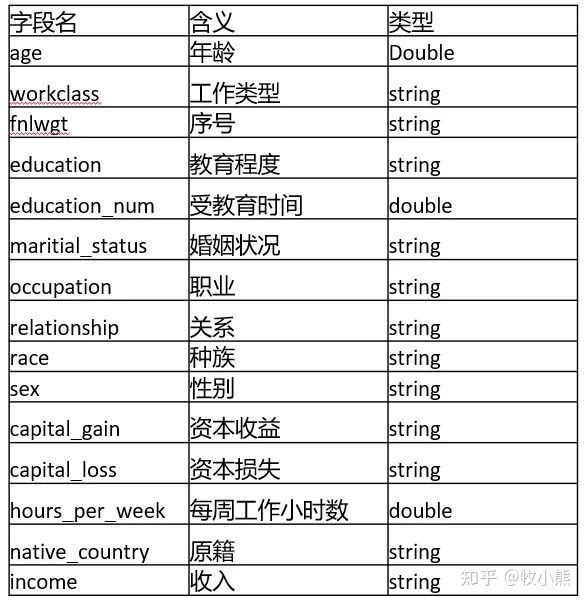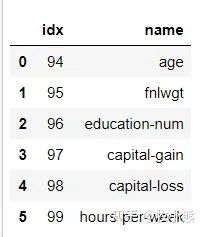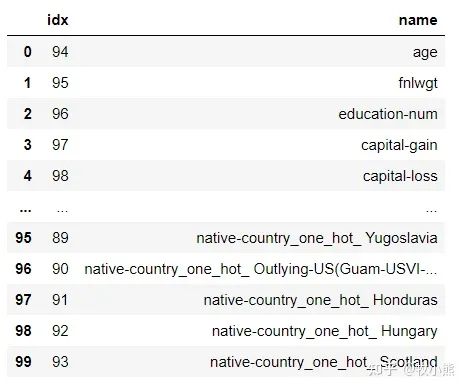【机器学习】在机器学习中处理大量数据!
知乎 | https://zhuanlan.zhihu.com/p/357361005
之前系统梳理过大数据概念和基础知识(可点击),本文基于PySpark在机器学习实践中的用法,希望对大数据学习的同学起到抛砖引玉的作用。(当数据集较小时,用Pandas足够,当数据量较大时,就需要利用分布式数据处理工具,Spark很适用)
1.PySpark简介
Apache Spark是一个闪电般快速的实时处理框架。它进行内存计算以实时分析数据。由于Apache Hadoop MapReduce仅执行批处理并且缺乏实时处理功能,因此它开始出现。因此,引入了Apache Spark,因为它可以实时执行流处理,也可以处理批处理。
Apache Spark是Scala语言实现的一个计算框架。为了支持Python语言使用Spark,Apache Spark社区开发了一个工具PySpark。我们可以通过Python语言操作RDDs
RDD简介
RDD (Resiliennt Distributed Datasets)
•RDD = 弹性 + 分布式 Datasets
1)分布式,好处是让数据在不同工作节点并行存储,并行计算
2)弹性,指的节点存储时,既可以使用内存,也可以使用外存
•RDD还有个特性是延迟计算,也就是一个完整的RDD运行任务分成两部分:Transformation和Action
Spark RDD的特性:
分布式:可以分布在多台机器上进行并行处理 弹性:计算过程中内存不够时,它会和磁盘进行数据交换 基于内存:可以全部或部分缓存在内存中 只读:不能修改,只能通过转换操作生成新的 RDD
2.Pandas和PySpark对比
可以参考这位作者的,详细的介绍了pyspark与pandas之间的区别:
https://link.zhihu.com/?target=https%3A//blog.csdn.net/suzyu12345/article/details/79673483
3.PySpark实战小练
数据集:从1994年人口普查数据库中提取。(后台回复“210323”可获取)
TO DO:预测一个人新收入是否会超过5万美金
参数说明:

创建SparkSession
from pyspark.sql import SparkSession
spark=SparkSession.builder.appName('adult').getOrCreate()
读取数据
df = spark.read.csv('adult.csv', inferSchema = True, header=True) #读取csv文件
df.show(3) #用来显示前3行
注意:pyspark必须创建SparkSession才能像类似于pandas一样操作数据集
我们看看数据集:
cols = df.columns #和pandas一样看列名
df.printSchema()
root
|-- age: integer (nullable = true)
|-- workclass: string (nullable = true)
|-- fnlwgt: integer (nullable = true)
|-- education: string (nullable = true)
|-- education-num: integer (nullable = true)
|-- marital-status: string (nullable = true)
|-- occupation: string (nullable = true)
|-- relationship: string (nullable = true)
|-- race: string (nullable = true)
|-- sex: string (nullable = true)
|-- capital-gain: integer (nullable = true)
|-- capital-loss: integer (nullable = true)
|-- hours-per-week: integer (nullable = true)
|-- native-country: string (nullable = true)
|-- income: string (nullable = true)
#找到所有的string类型的变量
#dtypes用来看数据变量类型
cat_features = [item[0] for item in df.dtypes if item[1]=='string']
# 需要删除 income列,否则标签泄露
cat_features.remove('income')
#找到所有数字变量
num_features = [item[0] for item in df.dtypes if item[1]!='string']
对于类别变量我们需要进行编码,在pyspark中提供了StringIndexer, OneHotEncoder, VectorAssembler特征编码模式:
from pyspark.ml import Pipeline
from pyspark.ml.feature import StringIndexer, OneHotEncoder, VectorAssembler
stages = []
for col in cat_features:
# 字符串转成索引
string_index = StringIndexer(inputCol = col, outputCol = col + 'Index')
# 转换为OneHot编码
encoder = OneHotEncoder(inputCols=[string_index.getOutputCol()], outputCols=[col + "_one_hot"])
# 将每个字段的转换方式 放到stages中
stages += [string_index, encoder]
# 将income转换为索引
label_string_index = StringIndexer(inputCol = 'income', outputCol = 'label')
# 添加到stages中
stages += [label_string_index]
# 类别变量 + 数值变量
assembler_cols = [c + "_one_hot" for c in cat_features] + num_features
assembler = VectorAssembler(inputCols=assembler_cols, outputCol="features")
stages += [assembler]
# 使用pipeline完成数据处理
pipeline = Pipeline(stages=stages)
pipeline_model = pipeline.fit(df)
df = pipeline_model.transform(df)
selected_cols = ["label", "features"] + cols
df = df.select(selected_cols)
因为pyspark显示的数据比较像Mysql 那样不方便观看,因此我们转成pandas:
import pandas as pd
pd.DataFrame(df.take(20), columns = df.columns)

通过pandas发现,好像还有较多字符串变量,难道特征编码失败了?
原来是使用VectorAssembler直接将特征转成了features这一列,pyspark做ML时 需要特征编码好了并做成向量列,
到这里,数据的特征工程就做好了。
分割数据集 测试集
train, test = df.randomSplit([0.7, 0.3], seed=2021)
print(train.count())
print(test.count())
22795
9766
可以看到,训练集和测试集安装7:3的比例分割了,接下来就是构建模型进行训练。
逻辑回归
from pyspark.ml.classification import LogisticRegression
# 创建模型
lr = LogisticRegression(featuresCol = 'features', labelCol = 'label',maxIter=10)
lr_model = lr.fit(train)
可以看到ML的用法和sklearn非常的像,因此使用起来也是相当的方便。
#结果预测
predictions = lr_model.transform(test)
看看predictions的结构
predictions.printSchema()
root
|-- label: double (nullable = false)
|-- features: vector (nullable = true)
|-- age: integer (nullable = true)
|-- workclass: string (nullable = true)
|-- fnlwgt: integer (nullable = true)
|-- education: string (nullable = true)
|-- education-num: integer (nullable = true)
|-- marital-status: string (nullable = true)
|-- occupation: string (nullable = true)
|-- relationship: string (nullable = true)
|-- race: string (nullable = true)
|-- sex: string (nullable = true)
|-- capital-gain: integer (nullable = true)
|-- capital-loss: integer (nullable = true)
|-- hours-per-week: integer (nullable = true)
|-- native-country: string (nullable = true)
|-- income: string (nullable = true)
|-- rawPrediction: vector (nullable = true)
|-- probability: vector (nullable = true)
|-- prediction: double (nullable = false)
抽取需要的信息
selected = predictions.select("label", "prediction", "probability", "age", "occupation")
display(selected)
selected.show(4)

技术AUC值
from pyspark.ml.evaluation import BinaryClassificationEvaluator
# 模型评估,通过原始数据 rawPrediction计算AUC
evaluator = BinaryClassificationEvaluator(rawPredictionCol="rawPrediction")
print('AUC:', evaluator.evaluate(predictions))
AUC:0.9062153434371653
进行网格调参
from pyspark.ml.tuning import ParamGridBuilder, CrossValidator
# 创建网络参数,用于交叉验证
param_grid = (ParamGridBuilder()
.addGrid(lr.regParam, [0.01, 0.5, 2.0])
.addGrid(lr.elasticNetParam, [0.0, 0.5, 1.0])
.addGrid(lr.maxIter, [1, 5, 10])
.build())
# 五折交叉验证,设置模型,网格参数,验证方法,折数
cv = CrossValidator(estimator=lr, estimatorParamMaps=param_grid, evaluator=evaluator, numFolds=5)
# 交叉验证运行
cv_model = cv.fit(train)
# 对于测试数据,使用五折交叉验证
predictions = cv_model.transform(test)
print('AUC:', evaluator.evaluate(predictions))
AUC:0.9054096433333642
决策树模型
from pyspark.ml.classification import DecisionTreeClassifier
# 创建决策树模型
dt = DecisionTreeClassifier(featuresCol = 'features', labelCol = 'label', maxDepth = 3)
dt_model = dt.fit(train)
#查看决策树结构
print(dt_model._call_java('toDebugString'))
DecisionTreeClassificationModel: uid=DecisionTreeClassifier_4bd113e9a3c2, depth=3, numNodes=11, numClasses=2, numFeatures=100
If (feature 23 in {0.0})
If (feature 97 <= 7792.0)
Predict: 0.0
Else (feature 97 > 7792.0)
If (feature 94 <= 19.5)
Predict: 0.0
Else (feature 94 > 19.5)
Predict: 1.0
Else (feature 23 not in {0.0})
If (feature 96 <= 12.5)
If (feature 97 <= 3368.0)
Predict: 0.0
Else (feature 97 > 3368.0)
Predict: 1.0
Else (feature 96 > 12.5)
Predict: 1.0
predictions = dt_model.transform(test)
predictions.printSchema()
root
|-- label: double (nullable = false)
|-- features: vector (nullable = true)
|-- age: integer (nullable = true)
|-- workclass: string (nullable = true)
|-- fnlwgt: integer (nullable = true)
|-- education: string (nullable = true)
|-- education-num: integer (nullable = true)
|-- marital-status: string (nullable = true)
|-- occupation: string (nullable = true)
|-- relationship: string (nullable = true)
|-- race: string (nullable = true)
|-- sex: string (nullable = true)
|-- capital-gain: integer (nullable = true)
|-- capital-loss: integer (nullable = true)
|-- hours-per-week: integer (nullable = true)
|-- native-country: string (nullable = true)
|-- income: string (nullable = true)
|-- rawPrediction: vector (nullable = true)
|-- probability: vector (nullable = true)
|-- prediction: double (nullable = false)
#计算AUC值
from pyspark.ml.evaluation import BinaryClassificationEvaluator
evaluator = BinaryClassificationEvaluator()
evaluator.evaluate(predictions)
0.7455098804457034
网格搜参数
from pyspark.ml.tuning import ParamGridBuilder, CrossValidator
param_grid = (ParamGridBuilder()
.addGrid(dt.maxDepth, [1, 2, 6, 10])
.addGrid(dt.maxBins, [20, 40, 80])
.build())
# 设置五折交叉验证
cv = CrossValidator(estimator=dt, estimatorParamMaps=param_grid, evaluator=evaluator, numFolds=5)
# 运行cv
cv_model = cv.fit(train)
# 查看最优模型
print("numNodes = ", cv_model.bestModel.numNodes)
print("depth = ", cv_model.bestModel.depth)
numNodes = 429
depth = 10
# 使用五折交叉验证进行预测
predictions = cv_model.transform(test)
evaluator.evaluate(predictions)
0.7850384321616918
随机森林
from pyspark.ml.classification import RandomForestClassifier
# 随机森林
rf = RandomForestClassifier(featuresCol = 'features', labelCol = 'label')
rf_model = rf.fit(train)
predictions = rf_model.transform(test)
predictions.printSchema()
selected = predictions.select("label", "prediction", "probability", "age", "occupation")
display(selected)
evaluator = BinaryClassificationEvaluator()
evaluator.evaluate(predictions)
0.8932162982538805
一样的方法
param_grid = (ParamGridBuilder()
.addGrid(rf.maxDepth, [3, 5, 7])
.addGrid(rf.maxBins, [20, 50])
.addGrid(rf.numTrees, [5, 10])
.build())
cv = CrossValidator(estimator=rf, estimatorParamMaps=param_grid, evaluator=evaluator, numFolds=5)
# 运行CV(大约6分钟)
cv_model = cv.fit(train)
predictions = cv_model.transform(test)
evaluator.evaluate(predictions)
0.8948376797236669
查看模型的结构和特征重要性
best_model
RandomForestClassificationModel: uid=RandomForestClassifier_15bbbdd6642a, numTrees=10, numClasses=2, numFeatures=100
best_model.featureImportances
太长了省略
df.schema['features'].metadata
temp = df.schema["features"].metadata["ml_attr"]["attrs"]
df_importance = pd.DataFrame(columns=['idx', 'name'])
for attr in temp['numeric']:
temp_df = {}
temp_df['idx'] = attr['idx']
temp_df['name'] = attr['name']
#print(temp_df)
df_importance = df_importance.append(temp_df, ignore_index=True)
#print(attr['idx'], attr['name'])
#print(attr)
#break
df_importance

for attr in temp['binary']:
temp_df = {}
temp_df['idx'] = attr['idx']
temp_df['name'] = attr['name']
df_importance = df_importance.append(temp_df, ignore_index=True)
df_importance

对特征重要性进行可视化
df_temp = pd.DataFrame(best_model.featureImportances.toArray())
df_temp.columns = ['feature_importance']
df_importance = df_importance.merge(df_temp, left_index=True, right_index=True)
df_importance.sort_values(by=['feature_importance'], ascending=False, inplace=True)
df_importance

4.小结
本节选用了一个常规的数据集,需要通过UCI提供的数据预测个人收入是否会大于5万,本节用PySpark对数据进行了读取,特征的编码以及特征的构建,并分别使用了逻辑回归、决策树以及随机森林算法展示数据预测的过程。
spark通过封装成pyspark后使用难度降低了很多,而且pyspark的ML包提供了基本的机器学习模型,可以直接使用,模型的使用方法和sklearn比较相似,因此学习成本较低。
往期精彩回顾
本站qq群851320808,加入微信群请扫码:
